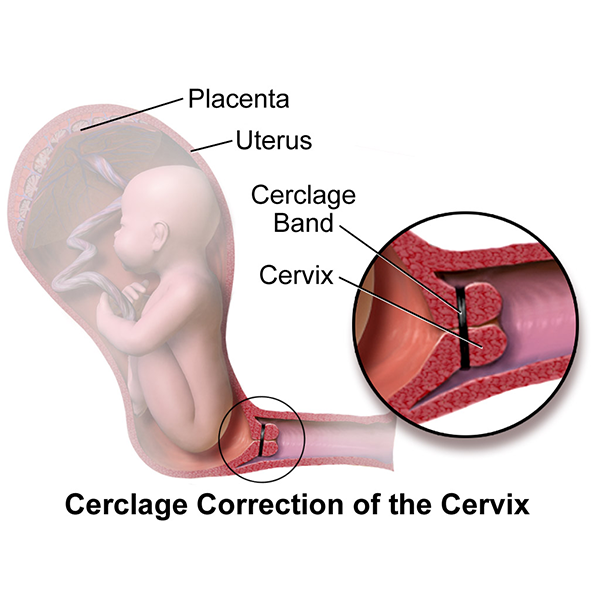Cervical cerclage or cervical stitch is one of the most essential procedures in modern pregnancy care. Without this valuable procedure, most moms would lose their dream of pregnancy. Because cervical cerclage has prevented a lot of premature pregnancy losses. Until McDonald introduced this method of cervical cerclage in 1957, there was no procedure to prevent premature deliveries and early pregnancy losses.
According to the World Health Organization (WHO), around 5 – 18 % of premature deliveries are usually happening worldwide. Even though most mothers are unfamiliar with this cervical cerclage procedure, it has significantly improved the pregnancy outcome in many unborn babies.
What is the importance of cervical cerclage?
What is a term pregnancy? Usually, a term pregnancy means delivery of pregnancy between 37 weeks to 42 weeks. Although Naegele’s formula says about an estimated delivery date for babies, it is a period than an exact date. So, average maturity needs at least 37 weeks of gestation.
If we do not have adequate maturity for a baby, he will face a lot of difficulties in the outside world. In addition, some systems may have needed to have developed more adequately. As a result, there are a lot of problems for these babies.
Some examples include patient ductus arteriosus, retinopathy of prematurity, acute respiratory distress, frequent infections, etc., like severe issues in these babies.
In addition to this immediate effect after birth, preterm birth is the leading cause of deaths below 5 years. All these happen due to the lack of maturity of the lungs, heart, brain, and other organs.
So we expect all the pregnancies to progress upto 37 weeks. That is why elective sections are done around 37 – 38 weeks. However, if the baby can progress upto 40 weeks, it also impacts increasing the birth weight.
The importance of cervical cerclage applies here for the progression of pregnancy until full maturity.
Causes for premature/ Preterm deliveries
There are a lot of causes for premature/preterm deliveries.
- Premature rupture of membranes (PROM)
- Cervical incompetence
- Idiopathic causes
- Multiple pregnancies
- Infection
- Placental abruption
- From all these, premature deliveries due to cervical incompetence can be corrected by a cervical cerclage.
Procedure for the cervical cerclage
Modern obstetricians use 3 major types of cervical cerclage procedures.
- McDonald trans-vaginal cervical cerclage
- Shirodkar trans-vaginal cervical cerclage
- Trans-abdominal cervical cerclage

McDonald’s Trans vaginal cerclage
Mcdonald’s procedure is one of the popular methods of cervical cerclage. This is probably done under regional anesthesia. Usually, there would be 2-3 stitches, according to the operator’s preference. The usual site of stitches is 2 O’clock positions and 10 O’clock positions. Additionally, there are instances of cervical stich at the 8 O’clock positions. However, all these depend on the operator’s preference and experience.
This needs tight nylon stitches and adequate exposure. You would be positioned in a lithotomy position, and two speculums would insert into the vagina to open up the canal. Then two stitches would be placed in the upper part of the cervix.
McDonald’s cervical cerclage Procedure by Dr. Rahul Jadhao
Mcdonald’s cerclage is placed external to the cervix. This is a temporary measure. You have to remove the stitches before the delivery, around 37 weeks.
Shirodkar’s Trans vaginal cerclage
Shirodkar procedure is a permanent cervical stitch rather than a temporary stitch. This would be placed inside the cervix. As a result, if you need to remove this stitch, you need regional anesthesia. Also, patients must undergo elective sections to prevent rupture of the uterus or cervix.
Although some procedures like Mcdonald’s procedure followed, it can’t be seen outside. You can keep the knots inside the cervix if you plan to have further pregnancies with elective sections.
Trans abdominal cervical cerclage
This is different from both Mcdonald’s procedure and Shirodkar’s procedure. Not like the other two, this procedure is done through the abdomen. However, this needs general anesthesia. Therefore is not performed much due to the risk of GA.
This procedure is also a permanent one. You have to plan an elective C-section before the contractions.
Risks of Cervical cerclage
Cervical cerclage is categorized as a procedure with less risk to the mother and the baby. However, there are still some common complications.
- Risk of General / Local anesthesia
- Risk of rupture of cervix or uterus during delivery
- Cervical rupture and bleeding during the procedure
- Cervical infections
- Infections of the Amniotic sac (chorioamnionitis)
From the above conditions, rupturing the uterus and cervix during delivery is one of the most critical conditions. Even though there is not much, this is a well-known and essential problem of cervical cerclage. Therefore, removing the cerclage before the onset of labor is very important. In addition to the ruptures occurring directly due to cerclage, there are some cervical problems associated with the cerclage.
Types of cerclages
Depending on the timely manner of the cerclage, we can divide them as an emergency and elective cerclages.
a. Elective cerclage
Elective cervical cerclage successfully prevents premature deliveries at 80%, while emergency cervical cerclage has a success rate of around 60%. The indication for elective cervical cerclages is the future risk of premature deliveries. However, there are some essential facts when deciding the future risk.
Indications for elective cervical cerclage
- Past history of late miscarriages
- Past history of premature deliveries
- Short cervical length less than 25mm
- Past history of cervical cerclage
- Contra indications for elective cervical cerclage
Contra-indications to cerclage
- Active bleeding
- Chorioamnitis
- Cervical infections
- Signs of placental abruption
- The anomaly of the baby
- Prolapsed fetal membranes (relative risk factors)
When to do the cervical cerclage?
This is yet a controversial topic. Some believe that it should be done in the early second trimester. For example, around 14- 16 weeks. However, it is essential to allow early miscarriages to happen due to genetic abnormalities. You can probably do the cerclage after the Anomaly scan is done around 18 – 20 weeks of pregnancy.
b. Emergency cerclage
Emergency cervical cerclage is sometimes used to delay premature delivery. However, this should be done only after expert assessment. You have to have the ability to inhibit the progression of labor. However, the cerclage should not be done in the presence of the above risk factors.
Care after cerclage
After the cervical cerclage, the patient should be observed for bleeding and premature delivery. The mother needs some bed rest after the procedure. She needs advice on the possible warning signs of early labor and the importance of timely removal of cerclage.
Is it safe to have sex after a cervical cerclage?
6 essential things not to do after cervical cerclage
Twin pregnancy Vs. Cervical stitch
I have seen instances we have to use cervical stitch in twin pregnancies. However, it is not generally accepted. The literature says there is no indication of cerclage in multiple pregnancies.
Reference:
Nashar, S., Dimitrov, A., Slavov, S., & Nikolov, A. (2009). Akusherstvo i ginekologiia, 48(3), 44–46.
Online at : https://pubmed.ncbi.nlm.nih.gov/20198764/
Preterm birth, World Health Organization, 19 February 2018
Online at: https://www.who.int/news-room/fact-sheets/detail/preterm-birth

